Does Distant Starlight Prove that the Bible is Wrong?
This article was written by the 4th Day AllianceThe question of distant starlight is probably the most frequently asked question to creation astronomers. Here we will discuss the issue and why it does not conflict with the truth of the Word of God.
The Distant Starlight Problem
The speed of light is currently measured at 186,282 miles (299,792 kilometers) per second.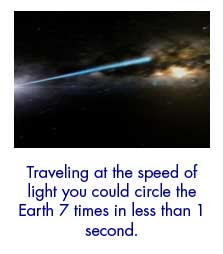
Using several different methods, astronomers have measured the distance to many distant stars and galaxies. Many of these distant light sources seem to be millions and even billions of light-years away from us. Apparently, this must mean that the light has traveled millions or billions of years to reach us. If this is true, then the Bible’s age for the earth and universe of about 6000 years must be wrong. Therefore, it appears that distant starlight has disproved the Bible!
This is the issue that has raged for some time. However, it is not as simple as it appears and the conclusions drawn above are based on several questionable assumptions.
First Things First
Many people have chosen to believe in a naturalistic view of origins (i.e. the big bang and macro-evolution) as opposed to a supernatural Creation ex nihilo (out of nothing) view of origins (as described in Genesis one) because of the so-called “distant starlight problem.” However, we encourage all honest-hearted individuals to examine the real evidence with an open mind and decide for themselves what true science actually tells us.The only current alternative to Biblical Creation is the Big Bang theory. However, the big bang also has a distant starlight problem. Therefore, for someone to choose the Big Bang over Biblical Creation would not make any sense. It would be like somebody stating that they did not drink coffee because of the caffeine content, so instead they drink soda pop. This is utterly foolish, because it is still has caffeine.
Essentially, many people have said that they won’t believe in Biblical Creation because of a distant starlight problem, so instead they believe in the Big Bang which also has a distant (and worse) starlight problem.
The Horizon Problem
The horizon problem is a problem with the standard cosmological model of the Big Bang that was identified back in the 1970s. It exposes how different regions of the universe could not have come in contact with each other, yet measurements show that the entire universe has the same temperature[1] and other identical physical properties. The only way this could be possible is if different regions of the universe exchanged energy with each other. Energy cannot be exchanged any faster than the speed of light, yet the distances needed to travel based on the evolutionary model for the size and age of the universe could not be traveled in the time allotted for the evolutionary age of the universe.So, the horizon problem clearly indicates that the universe is not old enough, or the speed of light is not fast enough, to match the theory of the Big Bang.
More Big Bang Problems
Other similar distant starlight problems are also now known. For example, some distant galaxies observed by the Hubble Space Telescope have an age, based on the assumption that the Big Bang is true, that is older than the age of the universe[2]. This obviously can’t be true because a galaxy cannot be older than the universe.Additionally, if the universe is only 14 billion years old (which evolutionists believe), then the following had to take place within that time period:
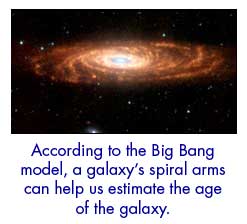
- The first generation of stars had to form.
- Many of these stars had to pass through their entire lifecycles and explode as supernovas so that heavier chemical elements (like carbon, iron, and uranium[3]) could be produced.
- Elements then would have to recollect enough of the exploded debris so that a brand new generation of stars could be formed. This process may even have to repeat itself several times before the heavier elements could form.
- This new generation of stars would then have to transmit their light billions of light-years away so that we could view them.
We have observed many distant galaxies surrounded by these heavy elements. For example, one galaxy observed with a quasar at its center would have taken 94% of the age of the universe for it’s light to reach us[4]. This means that steps 1-4 listed above would have to be accomplished in only 6% of the time of the assumed age of the universe. If the universe is 14 billion years old, then this leaves only .84 billion years available for steps 1-4 to take place. Even secular astronomers do not believe that these 4 steps could take place that quickly. This is a big problem.
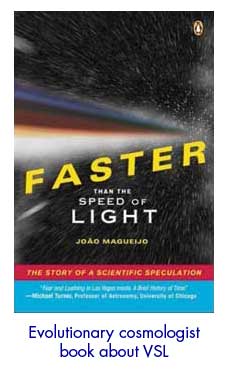
More Problems for Evolutionists
As you can see, distant starlight is a bigger problem for Big Bang believers than for Biblical creationists. Evolutionists may in time be able to solve these problems and contradictions, but if they do, they will have to let go of some long-held beliefs. Some evolutionists have already proposed the variable speed of light theory (VSL). This theory essentially states that light traveled faster in the past.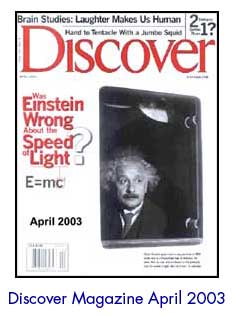

Other experiments were performed where the speed of light was slowed down[8], one where it was brought to a complete stop and then sent on its way again[9], and one experiment showed light pulses that actually exceeded the speed of light by a factor of 300[10]! The bottom line here is that we can no longer say with certainty that the speed of light is a constant through either time or space. This being the case, it is foolish to believe that the distant starlight problem undermines or disproves the Bible. In fact, the evidence we have today will undoubtedly be the foundation upon which future discoveries will be made which further establish and support the Biblical creation model of an approximate 6000 year old universe.
Creation Models for Distant Starlight
Several models have been proposed by creationists, which may provide the answer to the distant starlight question. We do not currently have enough evidence to further substantiate them, but nevertheless they may provide enough insight to send us on the right path towards discovery. We will discuss two of them here:Decaying light speed. This theory suggests that the speed of light was greater in the past (much like VSL) and therefore could have moved much more quickly allowing it ample time to reach earth[11].
Relativistic cosmology. This theory is based on Einstein’s theory of relativity. Based on the actual evidence that time moves at different rates in response to gravity[12], this theory posits that different timeframes exist at various locations depending upon certain factors (such as gravity and the geometry of the universe). Time is then relative to the observer. Therefore, when only a short amount of time has passed on Earth, there could still be adequate time in space for distant starlight to reach us[13]. One unique advantage that this theory has is that it is based on the universally accepted theory of relativity.
Conclusion
In short, our limited understanding of space, time, and light do not allow us to know with certainty how distant starlight can reach the earth in a relatively short period of time. Several possible ideas have been proposed which may ultimately prove to be accurate. Unfortunately, we cannot be 100% certain yet. However, we can know with certainty that the so-called distant starlight problem does not disprove the Bible for the following reasons:- The distant starlight problem is based on the assumption that the speed of light is a constant. New operational science experiments have shown this assumption to be invalid.
- Man does not know enough about light, space, time, nor the geometry of the universe to draw any empirical conclusions.
- The alternative model to Biblical Creation suffers from a worse case of the distant starlight problem and can therefore not be considered a viable alternative on the basis of the starlight problem alone.
- History has shown time after time that claims made in the Bible that are challenged by opposing views in science have always shown the Bible to be true in the end. This typically happens once enough data has been collected and once technology has advanced to the place to allow us to make better observations.
In addition to these facts, there are dozens of known, observable, physical processes that set limits on the age of the earth and universe[14]. Many books and articles have been written describing these processes in great detail. Overwhelming evidence exists which supports a young, 6000 year old creation, but problem-laden theories are all that exist to support a struggling, secular, billions-of-years old model. The truth is that people who believe in billions-of-years do so because they are intimidated by the opinions of the biased scientific majority, rather than on observable scientific facts. They have chosen to place their trust in the fallible opinions of men who are driven by the ulterior motive of denying God’s existence so they can feel justified living immoral lives[15], rather than placing their trust in Jesus Christ and obeying his Word. In short, they have opted to believe in a false theory that has never been proven right, instead of the Word of God, which has never been proven wrong.
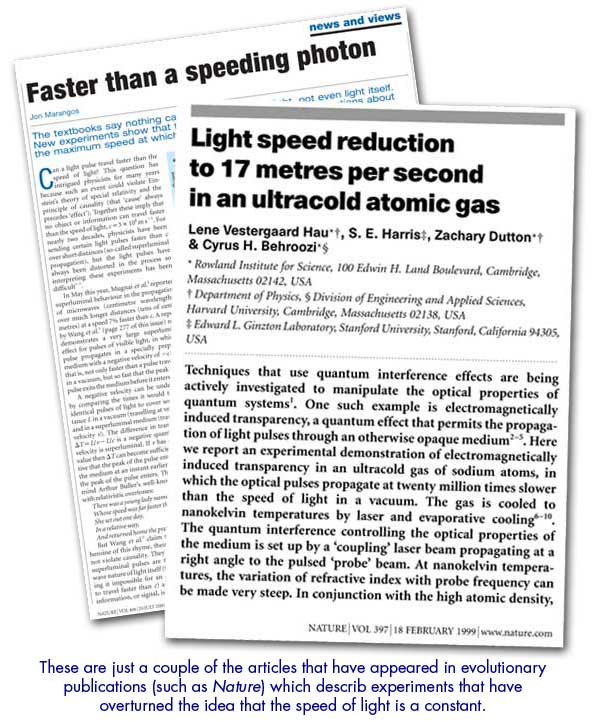
FOOTNOTES:
- Based on measurements of the cosmic microwave background (CMB) radiation.
- Robert C. Kennicutt Jr. “An Old Galaxy in a Young Universe” Nature, Volume 381, 13 June 1996, pages 581-584.
- Light from distant stars has shown that some distant stars contain these heavier elements. If the Big Bang occurred it could have only produced hydrogen and helium. Although there is no known process that can produce heavier elements out of hydrogen and helium (nuclear fusion does not apply because fusion won’t work beyond iron which is only number 26 on the periodic table), big bang believers generally believe heavier elements can be produced when a star goes supernova.
- Ron Cowen, “Newfound Galaxy Goes the Distance,” Science News, Volume 157, 27 May 2000, page 340.
- “Was Einstein Wrong?” Discover Magazine, April 2003.
- Jon Marangos, “Faster than a Speeding Photon,” Nature, Vol. 406, 20 July 2000, p. 243.
- Cherenkov radiation is electromagnetic radiation emitted when a charged particle passes through an insulator at a speed greater than the speed of light in that medium. It must be noted that light travels slower than c through water. However, the point here is that if electromagnetic radiation can travel faster than it typically does through one medium, then why not another medium. Furthermore, since we cannot really know what the medium of distant space really is, how can a scientifically honest person dogmatically claim that light cannot travel faster than c through time and space?
- Lene Vestergaard Hau, et al, “Light Speed Reduction to 17 Metres per Second in an Ultracold Atomic Gas,” Nature, Volume 397, 18 February 1999, pages 594-598.
- “Observation of Coherent Optical Information Storage in an Atomic Medium Using Halted Light Pulses,” Nature, Volume 409, 25 January 2001,
- L.J. Wang, et al “Laser Smashes Light Speed Record” Nature, Volume 406, 2000 page 277.
- For more information see www.setterfield.org.
- Two atomic clocks (one in Boulder, Colorado and one in Greenwich, England) that we have on the planet today are at different altitudes and are therefore subject to small differences in gravity. They actually have different time readings.
- For more information, see Dr. Russell Humphreys book, Starlight and Time.
- Examples are: helium diffusion rates, fission tracks, polonium radiohalos, carbon-14 in coal and diamonds, comet decay, human population, erosion of continents, natural gas in the earth, coral reef growth, oldest living plants, multi-layer fossils, etc.
- Aldous Huxley, the grandson of Thomas Huxley (who was famous for his ardent support and defense of darwinian evolution), made the following statement in “Confession of a Professed Atheist,” Report: Perspective on the News, vol. 3 (June 1966), p. 19. “…For myself, as no doubt for most of my contemporaries, the philosophy of meaninglessness was essentially an instrument of liberation. The liberation we desired was simultaneously liberation from a certain political and economic system and liberation from a certain system of morality. We objected to the morality because it interfered with our sexual freedom…” This admission is axiomatic and can still be widely seen among many scientists today.